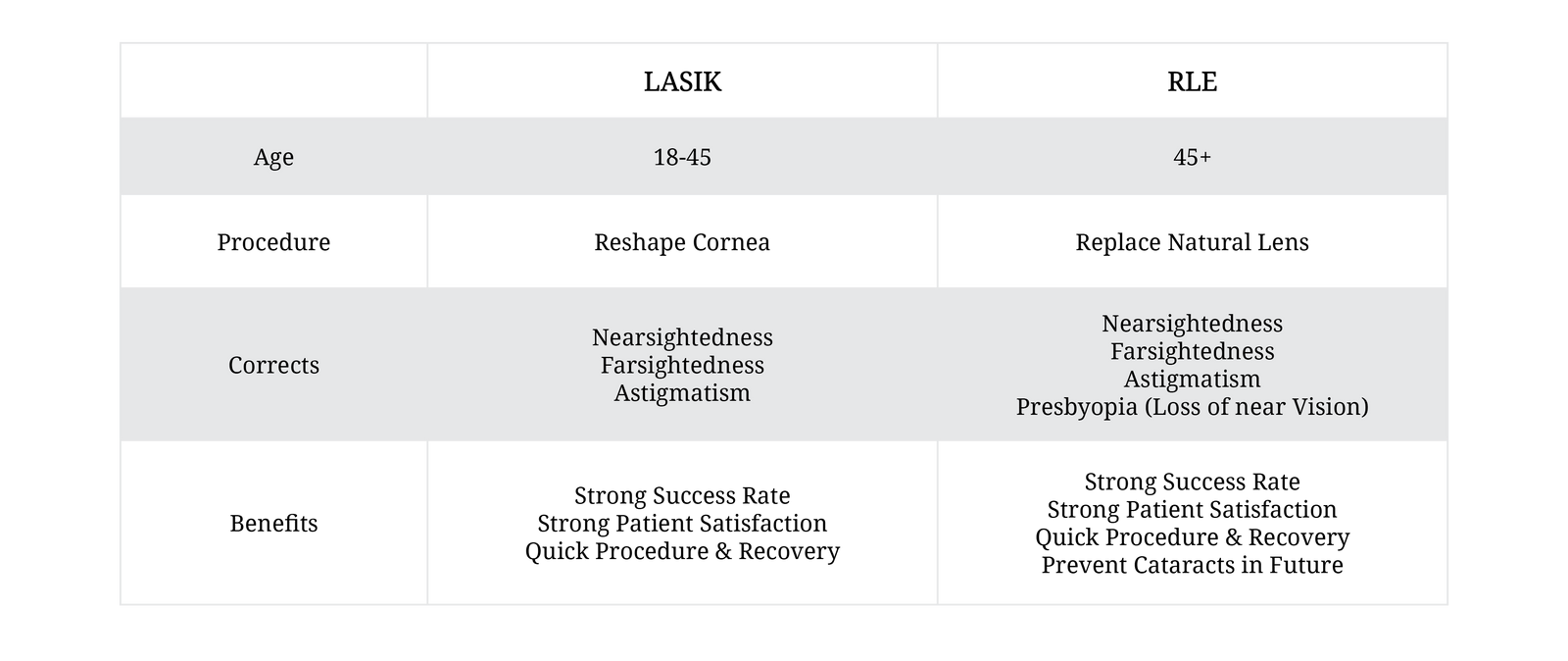

Another excellent option for vision correction is Refractive Lens Exchange or RLE. This would be a great alternative if you are tired of the hassle of contacts, glasses, or even readers and you aren’t a great candidate for LASIK.
RLE is one of our more popular procedures at Texas Vision as our experienced surgeons perform these every week. This long-term solution provides a lot of great benefits that our patients truly value. That value is important to us as we are determined to provide only the best care for each and every patient.

Refractive Lens Exchange is another lasting way we can correct vision. In this procedure, we are changing the prescription by replacing the lens inside of the eye as opposed to changing the cornea in the front of the eye, like we do in LASIK. In our 20s and 30s, our lenses are still flexible, which allows for us to focus and see things from far away all the way to up close. When we get into our 40s and 50s, we lose that flexibility which makes things difficult to see things up close, leading to the need for readers. The reason for this difficulty, is as we get older, proteins start to build up on the lens, which diminishes the quality of vision. Additionally, this build up stiffens the lens, which makes it harder for the lens to flex and change their focus from distance to near. That is why we typically notice ourselves holding things farther away from us to see them.
With RLE, we are easily able to correct this by replacing the old, hardened lens with a new, clear lens. This isn’t a new procedure as lens replacements have been performed for over 50 years. There are some distinct advantages to Refractive Lens Exchange. In RLE, we are replacing the lens with a permanent lens that you can use the rest of your life. Furthermore, cataracts usually develop in our 50s on the natural lens but by replacing this lens with a new, clear lens, you will never develop cataracts or need to have cataract surgery. You will be able to enjoy the use of these lenses the rest of your life.

Refractive lens exchange surgery is a popular and safe procedure that can allow you to experience greater visual freedom and improve your quality of life. It involves replacing your natural lens with an artificial intraocular lens (IOL) to correct refractive errors such as nearsightedness, farsightedness, and astigmatism. The procedure is the same as cataract surgery, which is one of the most commonly performed and safest procedures in medicine.
At Texas Vision, we will work closely with you to determine the most suitable intraocular lens for your specific needs and goals. There are many different types of lenses available, and we will select one with the appropriate power and flexibility to provide the best possible outcome. This personalized approach ensures that you receive the most effective treatment for your unique circumstances.
Refractive lens exchange surgery typically takes only seven to ten minutes to complete and is an outpatient procedure. This means that you will be able to go home the same day! The procedure is also associated with a very low risk of complications, making it a safe and effective option for improving your vision.
Whether you are seeking to reduce your dependence on glasses or contacts or simply want to enjoy clearer, sharper vision, refractive lens exchange surgery at Texas Vision can help you achieve your goals.

Schedule a consultation at Texas Vision at one of our 3 locations now!

Georgetown Office
4134 Williams Dr.
Georgetown TX 78628
Tel: (512) 551-5500
Fax: (512) 551-5509
[email protected]
Office Hours
Mon – Tues: 8:00 – 3:30
Wed – Fri: 8:00 – 5:00
Sat – Sun: Closed
Cedar Park Office
1130 Cottonwood Creek Trl Ste D4
Cedar Park, TX 78613
Tel: (512) 551-5500
Fax: (512) 551-5509
[email protected]
Office Hours
Mon – Fri: 8:00 – 5:00
Sat – Sun: Closed
Temple Office
5258 South 31st St
Temple, TX 76502
Tel: (254) 314-8001
Fax: (254) 314-8021
[email protected]
Office Hours
Mon – Thurs: 8:00 – 5:00
Fri: 8:00 – 12:00
Sat – Sun: Closed
Service Locations
*Please do not include personal identifying information such as your birth date, or personal medical information in any emails you send to us.